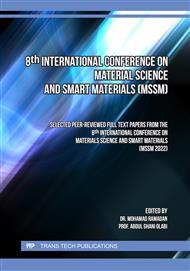[1]
T. Stefanou; G. Chance; T. Assaf & S. Dogramadzi, Tactile signatures and hand motion intent recognition for wearable assistive: robotics and AI, Vol.6, pp.124-124, 2019.
DOI: 10.3389/frobt.2019.00124
Google Scholar
[2]
Y. Chia, M. Rita, Soft robotic devices for hand rehabilitation and assistance: a narrative review. Journal of NeuroEngineering and Rehabilitation,2018.
DOI: 10.1186/s12984-018-0350-6
Google Scholar
[3]
R.F. Shepherd; F. Ilievski; W.Choi; S.A. Morin; A.A. Stokes; A. D. Mazzeo; X. Chen; M. Wang; G. M. Whitesides, Multigait soft robot. Proceedings of the National Academy of Sciences. 118,20400-20403, USA 2011.
DOI: 10.1073/pnas.1116564108
Google Scholar
[4]
D.B. Camarillo; C.R Carlson.; J.K. Salisbury, Configuration tracking for continuum manipulators with coupled tendon drive. IEEE Trans. Robot,25,798-808,2018.
DOI: 10.1109/tro.2009.2022426
Google Scholar
[5]
K. Elgeneidy; N. Lohse; M. Jackson, Bending Angle Prediction and Control of Soft Pneumatic Actuators with Embedded Flex Sensors-A Data-driven Approach Mechatronics, Mechatronics 50,234,247,2018.
DOI: 10.1016/j.mechatronics.2017.10.005
Google Scholar
[6]
G. Ponraj; S. K. Kirthinka; C. M. Lim, & H. Ren, Soft Tactile Sensors with Inkjet-Printing Conductivity and Hydrogel Biocompatibility for Retractors in Cadaveric Surgical Trials. Journal and Magazine, IEEE Sensors Journal, Volume 18, Issue:23,2018.
DOI: 10.1109/jsen.2018.2871242
Google Scholar
[7]
T. Agcayazi; M. McKnight; H. Kausche; T. Ghosh and A. Bozkurt, A finger touch force detection method for textile based capacitive tactile sensor arrays, 2016 IEEE SENSORS, Orlando, FL, pp.1-3, 2016.
DOI: 10.1109/icsens.2016.7808528
Google Scholar
[8]
H.K. Lee; S.I. Chang and E. Yoon, A Flexible Polymer Tactile Sensor: Fabrication and Modular Expandability for Large Area Deployment, in Journal of Microelectromechanical Systems, vol. 15, no. 6, pp.1681-1686, Dec. 2006.
DOI: 10.1109/jmems.2006.886021
Google Scholar
[9]
T. Kasahara; M. Mizushima; H. Shinohara; T. Obata; T. Futakuchi; S. Shoji and J. Mizuno, Simple and Low-Cost Fabrication of Flexible Capacitive Tactile Sensors. In Japan Journal Applied Physics, vol. 50, pp.0165026016502-5, Jan. 2011.
DOI: 10.7567/jjap.50.016502
Google Scholar
[10]
J.G. Rocha; C. Santos; J.M Cabral and S. Lanceros-Mendez, 3 Axis Capacitive Tactile Sensor and Readout Electronics, 2006 IEEE International Symposium on Industrial Electronics, Montreal, Que., pp.2767-2772, 2006.
DOI: 10.1109/isie.2006.296052
Google Scholar
[11]
Kim, W.S.; Lee, H.D.; Lim, D.H.; Han, J.S.; Shin, K.S.; Han, C.S. Development of a muscle circumference sensor to estimate torque of the human elbow joint. Sens. Actuators A 2014, 208, 95–103.
DOI: 10.1016/j.sna.2013.12.036
Google Scholar
[12]
Han, H.; Kim, J. Active muscle stiffness sensor based on piezoelectric resonance for muscle contraction estimation. Sens. Actuators A 2013, 194, 212–219.
DOI: 10.1016/j.sna.2013.01.054
Google Scholar
[13]
Guo, J.Y.; Zheng, Y.P.; Xie, H.B.; Chen, X. Continuous monitoring of electromyography (EMG), mechanomyography (MMG), sonomyography (SMG) and torque output during ramp and step isometric contractions. Med. Eng. Phys. 2010, 32, 1032–1042.
DOI: 10.1016/j.medengphy.2010.07.004
Google Scholar
[14]
Kenney, L.P.; Lisitsa, I.; Bowker, P.; Heath, G.H.; Howard, D. Dimensional change in muscle as a control signal for powered upper limb prostheses: A pilot study. Med. Eng. Phys. 1999, 21, 589–597.
DOI: 10.1016/s1350-4533(99)00089-2
Google Scholar
[15]
Jung, P.G.; Lim, G.; Kim, S.; Kong, K. A Wearable Gesture Recognition Device for Detecting Muscular Activities Based on Air-Pressure Sensors. IEEE Trans. Ind. Inform. 2015, 11, 485–494.
DOI: 10.1109/tii.2015.2405413
Google Scholar
[16]
Bansal, A.K.; Hou, S.; Kulyk, O.; Bowman, E.M.; Samuel, I.D.W. Wearable Organic Optoelectronic Sensors for Medicine. Adv. Mater. 2015, 27, 1521–4095.
DOI: 10.1002/adma.201403560
Google Scholar
[17]
Gargiulo, G.D.; Bifulco, P.; Cesarelli, M.; Jin, C.; McEwan, A.; van Schaik, A. Wearable dry sensors with Bluetooth connection for use in remote patient monitoring systems. Stud. Health Technol. Inform. 2010, 161, 57–65.
Google Scholar
[18]
Lebosse, C.; Renaud, P.; Bayle, B.; de Mathelin, M. Modelling and Evaluation of Low-Cost Force Sensors. IEEE Trans. Robot. 2011, 27, 815–822.
DOI: 10.1109/tro.2011.2119850
Google Scholar
[19]
Tiwana, M.; Redmond, S.; Lovell, N. A review of tactile sensing technologies with applications in biomedical engineering. Sens. Actuators A Phys. 2012, 179, 17–31.
DOI: 10.1016/j.sna.2012.02.051
Google Scholar
[20]
Y. Kadowaki; T. Noritsugu; M.Takaiwa; D.Sasaki; & M. Kato, Development of soft power- assist glove and control based on human intent. Journal of Robotics and Mechatronics, 23(2), 281, 2011.
DOI: 10.20965/jrm.2011.p0281
Google Scholar
[21]
D. Sasaki; T. Noritsugu,; M. Takaiwa,& H. Konishi, Control Method Based on EMG for power Assist Glove Using Self-Organizing Maps. Journal-ref: International Journal of Automation Technology, 8(2), 177-185, 2014.
DOI: 10.20965/ijat.2014.p0177
Google Scholar
[22]
K.C. Galloway; J.E. Clark, & D.E. Koditschek, Variable stiffness leg for robust, efficient, and stable dynamic running. Journal of Mechanisms and Robotics, 5(1), 011009, (2013)
DOI: 10.1115/1.4007843
Google Scholar



